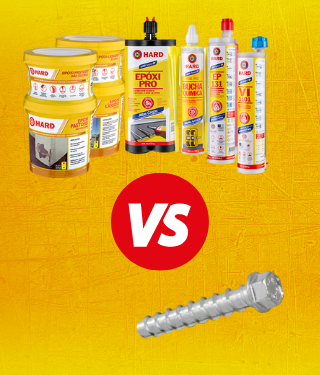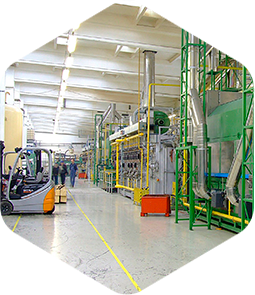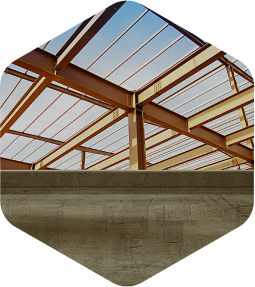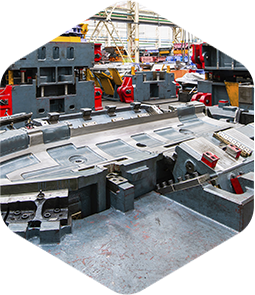When preparing a construction project, it is important to know the systems and products to be used. Among those that can be highlighted are the anchor bolts, very versatile items that can be used in different types of structures and renovations. Divided between chemists and mechanics, it is essential to know how to choose the most suitable anchor for the desired application.
In order to help to avoid mistakes, below we talk a little more about what they are and the applications of the two types of anchor bolts. In addition to that, we bring tips on how to choose the best one for your work. Keep reading!
What are mechanical anchors?
An anchor is a system capable of fixing two or more elements together within a work. The mechanical type uses friction or/and expansion to keep itself fixed and is divided between expansive and non-expansive. On our blog, we have a comparative article between these two types, check it out here.
The expansive model, commercially known as the parabolt, is attached to the surface by pressure. When it is inserted, turn the existing key at the top to make its base expand and anchor in the hole. The accommodation model, such as the Hardbolt, works similarly to a screw, i.e. it laminates the thread into the concrete, providing anchorage.
The mechanical anchor bolts are extremely versatile and can be applied in virtually any context where it is necessary to fasten two objects together. They can be used for anchoring pre-molded plates, in metallic shears, in storage systems (pallet racks), etc.
What are chemical anchors?
The chemical anchors are a system composed of two elements, resin and hardener, which react and form a product with high adhesion power. The proportion and way of mixing these two elements depends on the type of chemical anchor, which can be pre-mixed (potty anchors), ampoule and injectable. The main chemical bases are epoxy and vinilester.
This type of anchoring can be used in bars, stainless steel systems, conventional bars, areas with a high vibration index, installations close to edges, among others. Because of this high versatility, chemical anchoring is widely used.
7 tips on how to choose the most suitable anchor for your work
When you have to decide which anchor to use in your work, there are many aspects that must be considered when choosing the best product. See below some of these factors and how to identify them.
1. Dynamic loads
Mechanical anchor bolts have a limitation when it comes to dynamic loads, i.e. they move frequently. Let’s think, for example, of fixing equipment, which constantly vibrates. If any type of mechanical anchor is applied, over time, it can open the hole and come loose, as it works through accommodation.
Therefore, chemical anchors are the most suitable for this type of application, to guarantee a safe and lasting anchorage. As it works by adhesion, there is no risk of this application weakening over time, not even when it is subject to daily vibrations.
2. Cargo capacity
As important as choosing a dynamic load resistant anchor is making sure that its load capacity meets your demand. Since each anchor has its limit and, if not respected, there may be deformation or wear.
Mechanical anchor bolts have a high load capacity, but if the application you need to do exceeds this limit, you need to choose between chemicals. With this type of anchor, it is possible to expand the hole and use more material, until the load capacity is sufficiently increased.
3. Edge proximity or/and shorter distance between anchors
The non-expanding type mechanical anchor, such as the Hardbolt, allows less proximity to the edge and between the anchors, without the risk of bursting the concrete. This is precisely due to its thread shape, which does not expand in the hole. As there is no such increase inside the hole, chemical anchors can also be used in applications that require a smaller margin of distance.
4. Environment type
The type of environment where the application will be made also influences the choice of anchorage. More aggressive locations, such as those exposed to the sea air or close to manufacturing areas, require more resistant coatings. This is because the wrong choice of coating can result in the weakening of the application, putting those who frequent the place at risk.
Currently, it is possible to find mechanical anchors in the most diverse types of coating. In non-aggressive environments, white zinc plating will perform its function safely. However, if the anchor will be in a location with direct and prolonged exposure to corrosive agents, Hard offers Ecoseal, the coating that delivers the highest corrosion resistance in its category. In addition to this, in the case of Hardbolt, it is possible to choose the item in carbon steel or stainless steel, with the second option offering greater resistance.
Chemical anchors can also be used in more aggressive environments, just be careful when choosing the bars used in the application. Generally, in these cases, they are more cost-effective compared to the use of mechanical anchors.
5. Inventory control
As chemical anchors have an expiration date, stock control is essential. For example, if a large quantity of this item is purchased near expiration, there is a high risk of losing some of this material. With mechanics there is no such concern, as this type of anchor has no expiration date, of course respecting the storage guidelines.
6. Release for use
Mechanical anchor bolts have the advantage of being usable immediately after application, as they have immediate load responses. However, chemical need some time for the substance to settle, which can delay some services. As already stated in this article, this system is divided between epoxy and vinylester-based systems, and the curing time varies from one type to the other.
Epoxy-based anchors have a slower cure time, so they are recommended for warmer regions. While the use of vinylester is indicated for cold regions, due to its shorter curing time. The ambient temperature directly influences the curing process of the material. So, for example, if a vinylester is used in an environment with higher temperatures, the product will cure so quickly that it cannot be used. While the use of epoxy in low temperature environments can result in an extremely time consuming cure.
7. Concrete strength
Identifying the strength of the concrete is also important for choosing the type of anchor. Since in substrates with low strength, mechanical anchors dust in the hole. While in high-strength concretes, this type of anchoring will not be able to laminate the substrate, and the item may break or damage the tool.
However, chemical anchors present excellent results in low and high strength concretes.? This is because the hole will be filled with the substance that will cure inside, without running the risk of losing the material.
The choice depends on your demand
The answer to the question “How to choose the anchor bolt for my work?” depends on numerous factors. As always, the most important advice is to prioritize safety and choose the anchor that best meets the requirements of your work.
Mechanical anchor bolts are versatile options, which can have highly durable coatings, are quick and easy to apply, in addition to presenting the same behavior regardless of the temperature of the place. However, they have a load and vibration limit, issues that are not a problem for chemical anchors.
Regardless of your choice, Hard has the best options for both types of anchor bolts. Did you have any questions? Contact us so we can help you!






Comentários
Ainda não há comentários. Seja o primeiro a comentar.